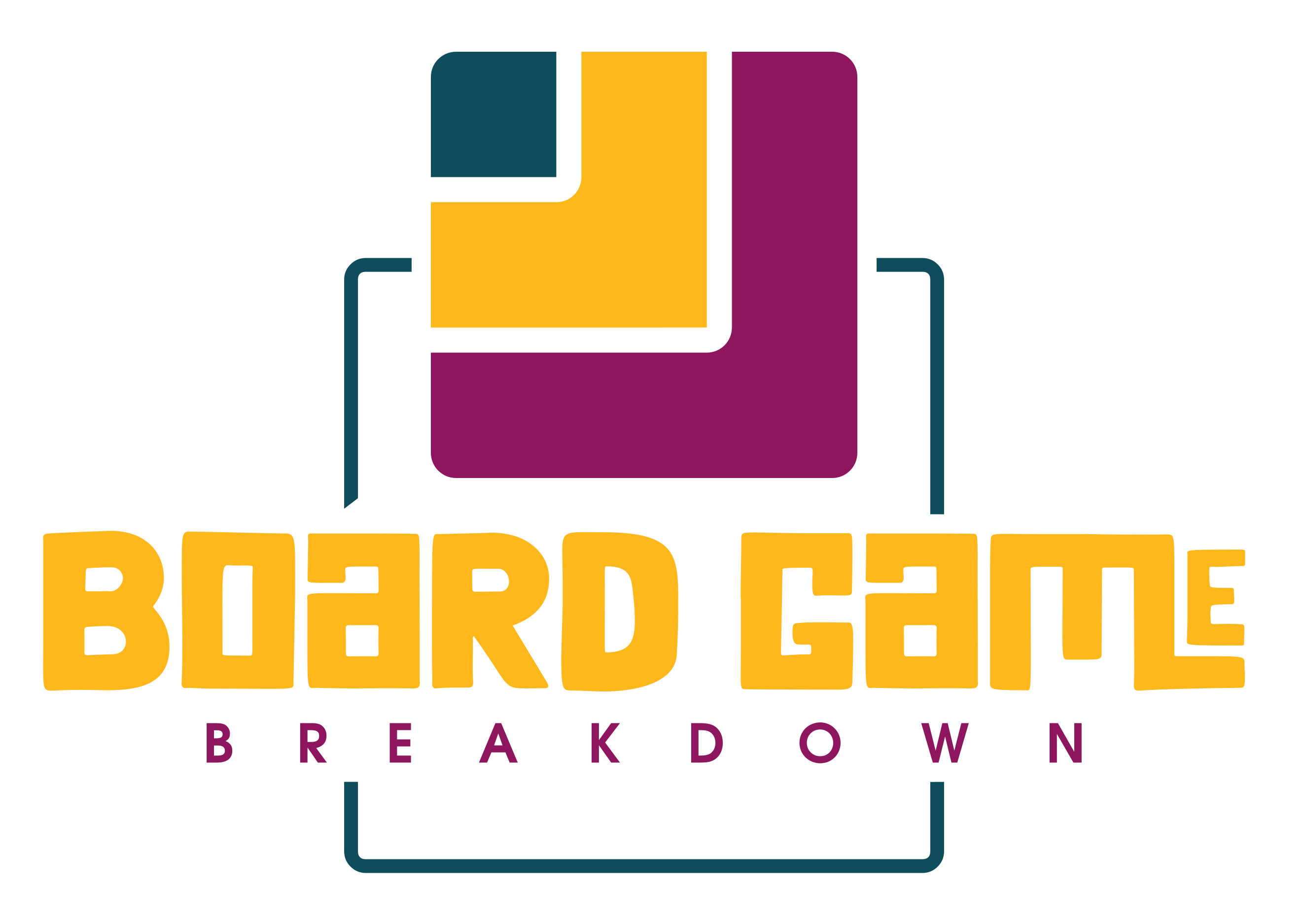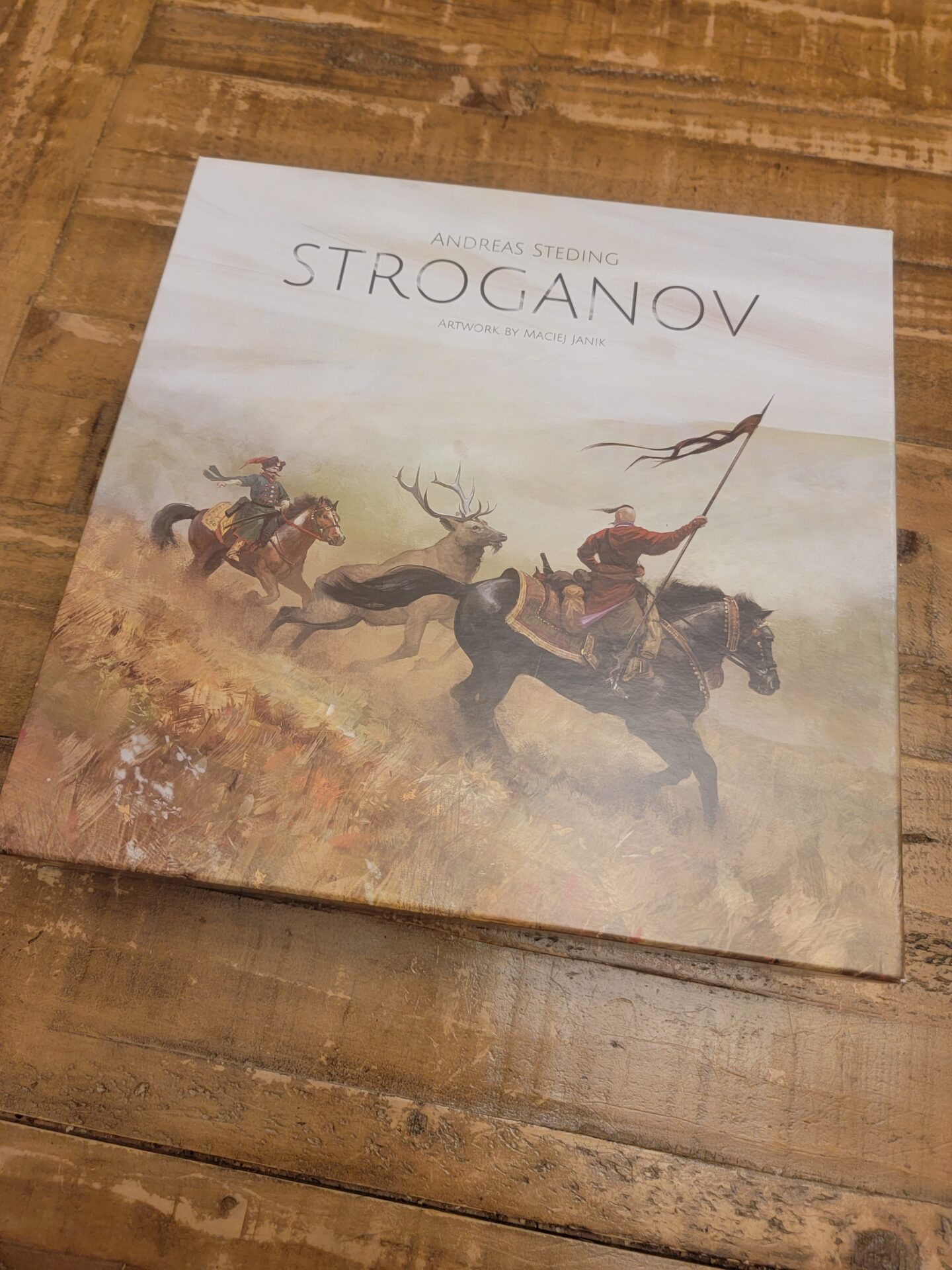
Name: Stroganov
Year of Release: 2021
Player Count: 1 – 4
Playing Time: 90 Minutes
Designer: Andreas Steding
Publisher: Game Brewer
Primary Mechanisms: Action Points, Worker Placement, Point to Point Movement, Set Collection
Weight (According to BGG.com): 3.27
Overview
The prospect of discovery is such an exhilarating aspect of life and such a fundamental part of the human experience. Ok, yes, this might be quite a heady statement to start a review for a board game, but I’m struck at how fun it is when you discover a new gem in whatever field or hobby you dabble in. I’m a music lover and for the past two decades, on probably a weekly basis, have scoured a multitude of music websites to discover new tunes and when one of these finds really hits, there just isn’t another feeling like it.
The sheer quantity of high-quality board games being released every year is quite mind boggling. And while I know that FOMO (fear of missing out) is real, I also get excited knowing that I can go into a local gaming store, browse the shelves, and still find hidden gems. This recently happened with Stroganov, when I was at a store (shoutout to Level Up Games) in Athens, Georgia. Now, it’d be a little disingenuous to say I had never heard of Stroganov. I had seen it mentioned on a list on Dice Tower, had quickly notated the name down in a list on my phone, and then never thought of it again. I didn’t even really know what it was about but seeing the name jogged something in my head and I had to take out my phone and check the list. There was that name so at some point in the past, I had at least thought this might be a good match. I read on the box that it was playable solo (which is what I’ll be concentrating on in this review) and then the store clerk moseyed over and told me because it was Memorial Day, everything was 25% off. Enough said.
Read on to see if this game that was (almost) unknown to me rewarded my sense of discovery or was there a reason why I’d never seen it mentioned or talked about… except for that one time.
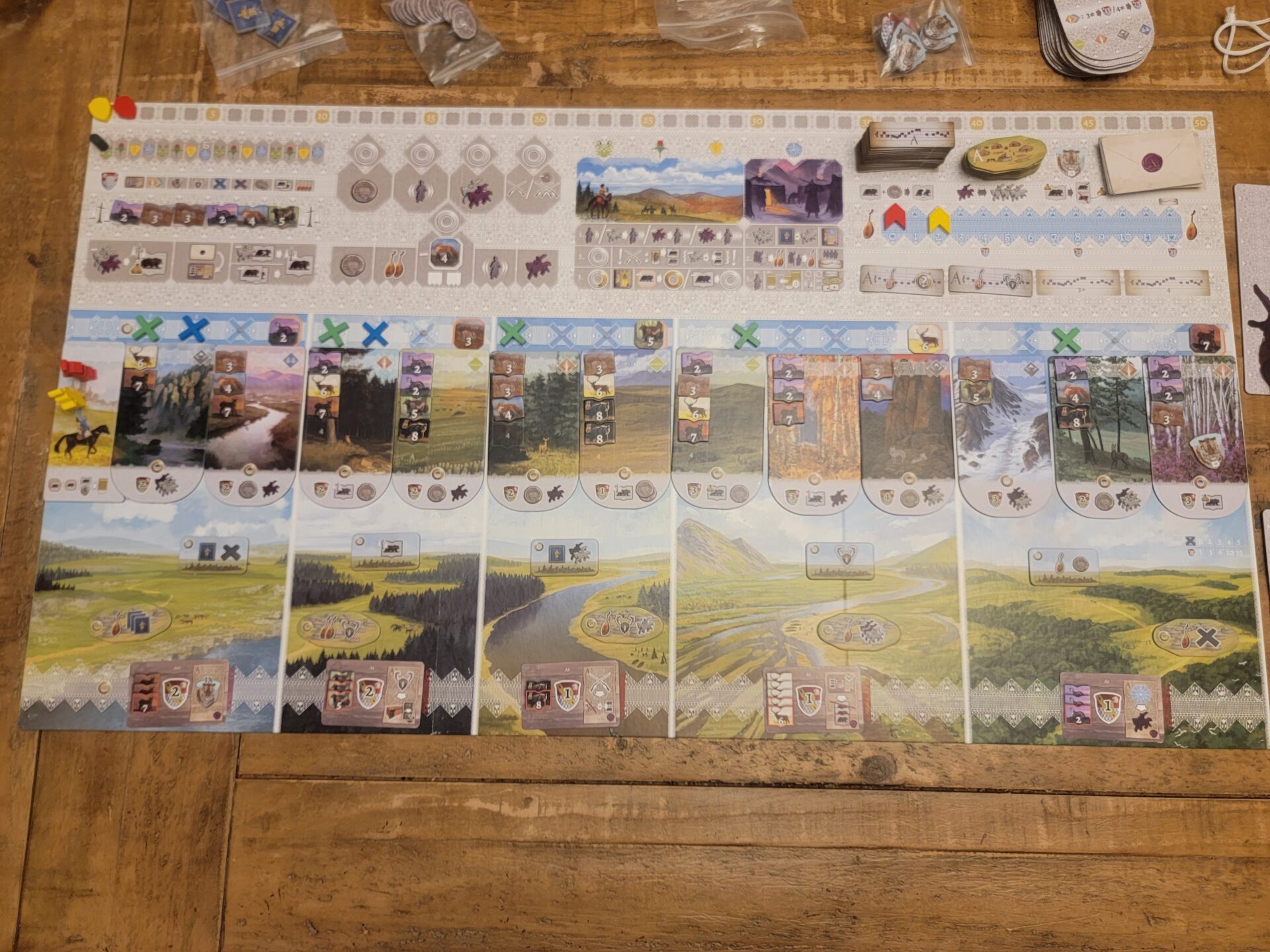
Rulebook & Components
If you’ve never seen a pic of Stroganov in play, then 1.) scroll up slightly because you missed a perfectly good picture and 2.) you won’t quite have an appreciation for how much is going on with the board. And it’s quite the long board, much like Ark Nova. I bring all this up because I find it rare that a game with this much going on isn’t going to have a weighty rulebook to match. But that doesn’t mean the player needs to be a genius to decipher it, hopefully it’s the opposite and the creators have put in enough time for the rulebook to be easily understandable by even the most novice of players.
For the most part, Stroganov gets it right, and while the rulebook is a heaping mass of text and pictures, it walks players through the game well enough where there should only be minimal questions during the first few games. Now, you’ll notice I said, “for the most part” and that is because the section explaining exactly what performing an Action entails, is… horrible. Between mentions of Basic Actions, Main Actions, Advanced Actions, as well as actions that are Free and some that are at a Cost, the whole thing is kind of a mess, and I can’t believe that there wasn’t a better way to lay this out. I ended up playing my first few games, totally missing one of my free actions and was wondering the whole time, “How does anyone win this solo?” Only after visiting a BoardGameGeek forum and seeing some people with similar questions, did I realize that I had understood this part of the rulebook poorly and spectacularly poorly at that. Though this is the only section of the rulebook that I felt could have been handled better, it did have a huge impact on the play of the game and for that, it leaves a more negative imprint on me than if the complication would have been focused on a smaller portion of the game.
As far as the solo version goes, that section of the rulebook is fine. There are a lot of things to remember when playing for Ivan, the AI player, but the rulebook lays them out in a nice order so you can quickly reference it while playing. I did have to keep the rulebook close by for the solo mode, but that was more because of the complexity of the game, not the rulebook itself.

If you’re a fan of punching out cardboard tiles, then you’re in luck with Stroganov! There are probably close to 250 chits and tiles to punch out, so we are definitely approaching or exceeding Tiletum numbers here (see a quick video on the excellent Eurogame Tiletum here.) The artwork on the Landscape Tiles and the Player Boards is especially beautiful. There is a lot of Iconography to get used to, but it is incorporated into the components in smart ways and helps to streamline play once players are used to what each means. The solo version comes with a Player Board specifically for Ivan as well as a deck of Automa Cards. I love just about any game that implements a deck of Automa Cards as it (usually) makes the AI feel and play much more like a human player and the same is true here in Stroganov.

Setup
Let’s get it out of the way, setup in Stroganov is a… bear (that pun will land once you play the game.) The time sink is almost solely caused by the act of putting the Fur Tiles out on each of the Landscape Tiles. This consists of pulling out handfuls of tiles from a bag and placing them on each Landscape Tile except with the added bonus of having to order the tiles from Lowest Amount to Highest Amount. Honestly, most of all of the setup is similar in that you are placing out Village Tiles, Song Tiles, and Yurt Tiles into their respective places on the board. There is also the small hiccup that many of the tiles are sorted into an A version and a B version so if you didn’t take the time to separate these when cleaning up the last game, you’ll have to spend some extra time handling that. Outside of shuffling the Automa Cards, there isn’t much difference in setup between the solo version and the multiplayer game so that is a plus as you don’t have to try to remember any solo-only alterations. Ok, so now that the setup is in place, let’s talk about what we’re really all here to talk about, the gameplay…
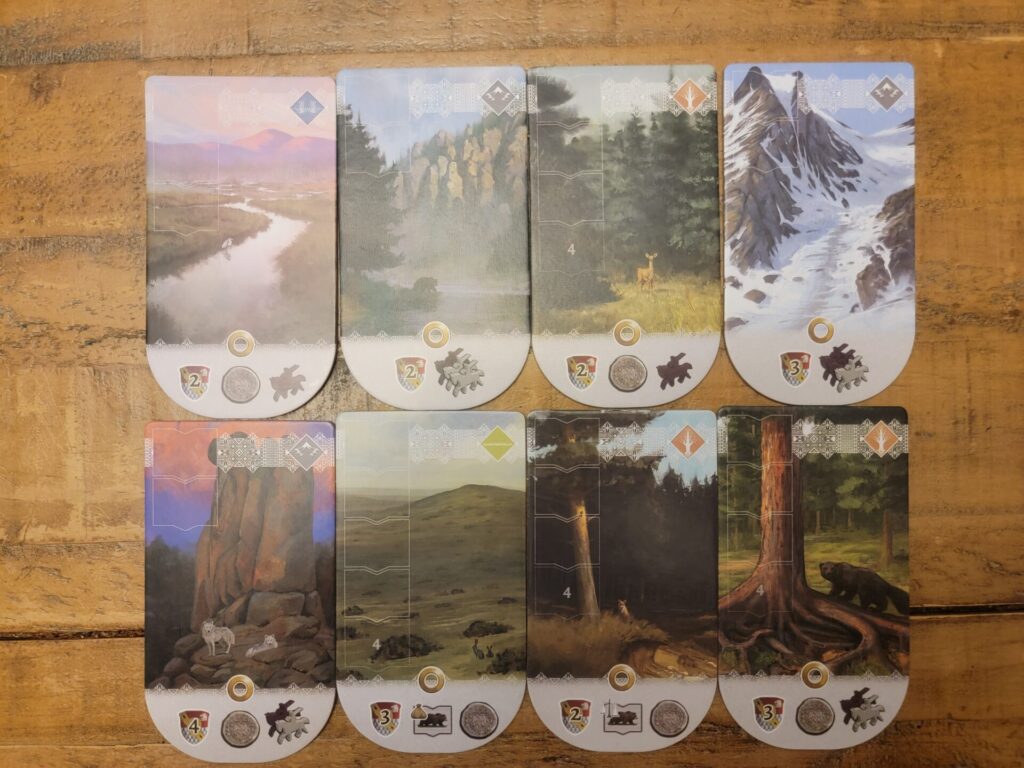
Gameplay
Stroganov is played over Four Years, each split into Four Seasons. Novel concept, eh? The Spring, Summer, and Autumn seasons are played in an identical fashion, with the Winter season being the outlier, and acting more as a time to score and reset the board. After giving the rulebook all that grief above, I’m going to now attempt to outline how a season works and hopefully not confuse the heck out of all of you readers. First, we’ll look at how your turn works, and then look at how Ivan, the AI player, handles his round.
When you are the active player, the first thing you have to do is Move your Cossack Meeple on the track of Landscape Tiles. Unlike a lot of games that use the “ratchet” system, where a player can only move one way (think Parks), Stroganov allows a player to move their meeple both backwards and forwards down the Landscape Track. By default, a player can only move their meeple either one or two spaces, but they can alter this by paying additional Horse Tiles. By doing so, a player can add an additional one, two, or three spaces to their movement, but will lose one, three, or six horses respectively.
Once the movement is complete, players are going to perform one Basic Action. Note that the Basic Actions are characterized by a silver ring on the board. Keeping this in mind will definitely make the balance of your turn easier to understand. The Basic Actions consist of five options:
- Take a Coin from the general supply. Coins are going to be useful in enabling you to Hunt for additional Furs and allowing you to change the values of said Furs.
- Take four Horses from the supply. The white Horse Tiles count as one horse and the burgundy tiles count as three horses.
- Move your Cossack Meeple an additional one or two locations. Please note that during this Move action, you cannot use Horse Tiles to adjust how many spaces your Cossack can move.
- Take the Hunt action which is one of the main ways of collecting Furs. The player is able to take the lowest valued Fur Tile at his/her current Location for free. If the player would like a more valuable fur, they can spend a Horse Tile for each fur they skip over. Additionally, the player can spend one Coin, to hunt an extra fur during this same action.
- The last action is to Trade which allows the player to discard a specific type of fur (selected during Setup) and then take two additional actions from a more contained list.
Ok, so this is where the turn can get a little confusing so let’s review really quick. As the active player, you’ve Moved your Cossack and then you’ve taken one of the five Basic Actions outlined above. Now, you are going to perform one or two Main Actions. The first Main Action will be free, and the second will cost a certain amount of Fur Tiles. But here is another kicker, your Main Action can be one of the Basic Actions we’ve already discussed, or it can be an Advanced Action. Similar to the Basic Actions, there are five different Advanced Actions so let’s look at those now.
- Visit a Village. On the board, you will see that it is split into five regions. Each of these regions had a Village tile placed on it during setup. As one of the Advanced Actions, players can visit this Village and gain the actions or benefits printed on the tile. The Village tiles stay on the board and are not removed by the player.
- Use a Yurt. Much like the Village Tiles, there is a Yurt Tile for each region. The difference here is that when a player uses a Yurt, after gaining the actions or benefits from the tile, they then remove the tile from the board. It will be refilled later on during the Winter season.
- Take a Tsar’s Wish Card. There is one of each of these cards placed in each region. These cards show the player a certain amount of fur the Tsar wishes you to collect. You must use this action to place a card into your inventory so you can eventually turn it in for rewards.
- Build an Outpost. The Outposts are represented by “X” tokens that each player is given during Setup. Up until this point, players would only be able to take these Advanced Actions in the region that their Cossack inhabited. Building Outposts allows you to have more choice in which region that you will perform your actions in, as your Outpost will act as your Cossack in future rounds.
- Lastly, players can buy the actual Landscape Tile their meeple is located on. This is going to cost a multitude of furs, especially if the tile still holds Fur Tiles that were never hunted. The upside is that sets of the collected Landscape Tiles will give additional Victory Points at game end.
On a turn, a player Moves their meeple. They then perform one of the five Basic Actions. They then perform one Main Action for free (which can be a Basic Action or an Advanced Action.) Then they can perform another Main Action but for a cost (but again this action can be another Basic Action or an Advanced Action.) Make sense?

Outside of this, there are a few things that a player can do throughout their turn that don’t take up actions and can just be completed. Two of these (Buying Furs or Trading Furs) gives players a way of turning in Fur Tiles or Horse Tiles to get needed Fur Tiles from either the bag or the Bank. The third “non-action” one can take is to Fulfill a Tsar’s Wish Card. If a player already has the card in their inventory, and they’ve collected the needed Fur Tiles, they can turn these in to gain the reward on the card. Many of these cards award players with an ongoing benefit that is triggered during certain seasons or when certain requirements are met during play.
Lastly, there are two tracks I have not talked about yet but that are important. The first is the Story Track. Your token moves up this track whenever you collect tiles with the… lute (?) icon on it. At year’s end, players will spend the points accumulated on the Story Track to buy Story Tiles, which give them additional benefits or Victory Points. The second track is the Trophy Track. This is a track that each player has printed on their individual player boards. As they gain tiles or take action with the Trophy Icon, they can pay the specific kind of fur that the next level needs and move their token up the Trophy Track. Much like the other tracks, these levels will give you increased benefits but will also reward quite a few Victory Points at the end of the game.

As far as Ivan’s turn goes, his decisions are based on a deck of cards. The player will flip over the top card and use the front of this card combined with the back of the next card to determine what actions Ivan will take. Most of his actions will follow exactly how a regular player’s turn goes so if you’re familiar with everything we touched on above, it shouldn’t be a problem to handle Ivan’s turn. He has a few things that are changed to help make it fair, but these small changes are outlined nicely in the Solo Play section of the rulebook.
After the player and Ivan have taken their turn, the season track is moved forward one season. When the tracker hits Winter, there is some administration where regions are refilled with Yurts, Wish Cards, etc. and Story Tiles are bought. Cossacks are moved back to the starting Location Tile, and the next year starts again, and play continues until all four years are completed.
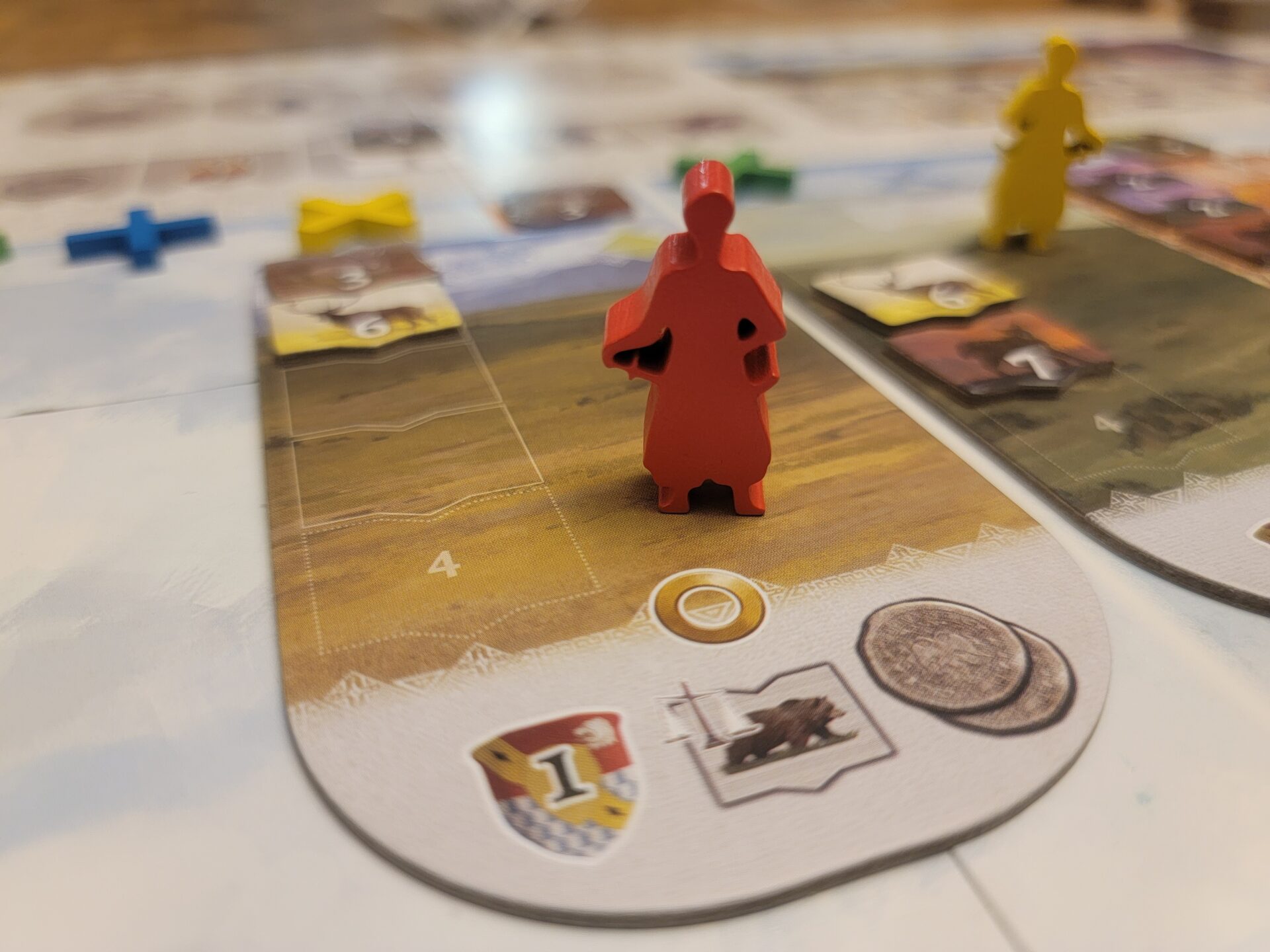
Conclusion
I really love Stroganov from a solo perspective especially once you’ve become familiar with the flow of the game. Yes, some turns can become heavy with the “I need to trade this fur for that fur and then spend these Horse Tiles for this other fur and then combine them with this coin which allows me to turn in a Wish Card to gain this benefit that gives me something extra each season” but I personally like games like that. The cards that control Ivan are really nicely done and replicate playing against another player almost perfectly. While I wish setup and tear down didn’t take as much time as they do, I’ve never felt that it wasn’t worth it after I finished a game as the gameplay is just so rewarding. At the time of writing this, a Kickstarter for a modular expansion just wrapped up so I hope that means that Stroganov’s popularity is gaining as I really want more people to know about this fantastic game.
Rating
Ratings are based on 5 main criteria: rulebook, setup, components, art & graphic design, and gameplay. The first 4 criteria are rated 1 to 5 and the gameplay is rated 1 to 10. These scores culminate in an “overall satisfaction” score that is rated from 1 to 10. If the reviewed game has both a solo and multiplayer mode, I have assigned scores separately to give context to which mode we enjoy more.
Links
As an Amazon Associate I earn from qualifying purchases.
